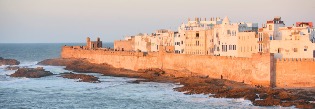Case-study /
Morocco: Sea-Level Rise and Impacts in Africa, 2000 to 2100. Application of the DIVA model to Africa.


Atlantic coast in Morocco. Image: © kerdowney.com/
Impact of sea level rise in Morocco
Morocco’s 3,500km coast crosses temperate, semi-arid and desert climatic zones. The coast in many locations is physically and socio-economically vulnerable to accelerated sea-level rise, mainly due to its low topography and high economic, touristic and ecological values. Population growth is rapid in urban coastal zones. It is projected that between 1985 and 2025, the urbanised area will increase six fold (Snoussi, 2000). Thus the coast is under pressure from housing and development, tourism, mining, and over-fishing. Low-lying land where further flooding due to sea-level rise could potentially occur are the Nador lagoon, the river Moulouya and its delta (e.g. Ericson et al., 2006), and the low-lying coastal plains of Oued Nekkor and Oued Laou. Flooding would also affect many coastal hotels and industries which are located behind dune complexes. With a 2m sea-level rise, 24% of the eastern coastal area could be lost including urban (30%), agriculture & vegetation (29%), marshes (7%), and beaches (7%), most of them being the low-lying lands of the Moulouya delta and some parts of the coast where the natural coastal defences (e.g. dunes) have been destroyed (Snoussi et al., 2008). Culturally, climate change would threaten the historic city of Essaouria through saltwater intrusion, coastal erosion and land substance as further pressure is out on water resources due to rising temperatures (Snoussi, 2000). A mix of hard and soft protection measures could help overcome sea-level rise and related problems, but care needs to be taken as hard defences could lead to unexpected and unwanted adverse impacts.
Suggested citation
Brown, S., Kebede, A.S., and Nicholls, R.J. (2011). Sea-Level Rise and Impacts in Africa, 2000 to 2100. University of Southampton, UK, 215pp
